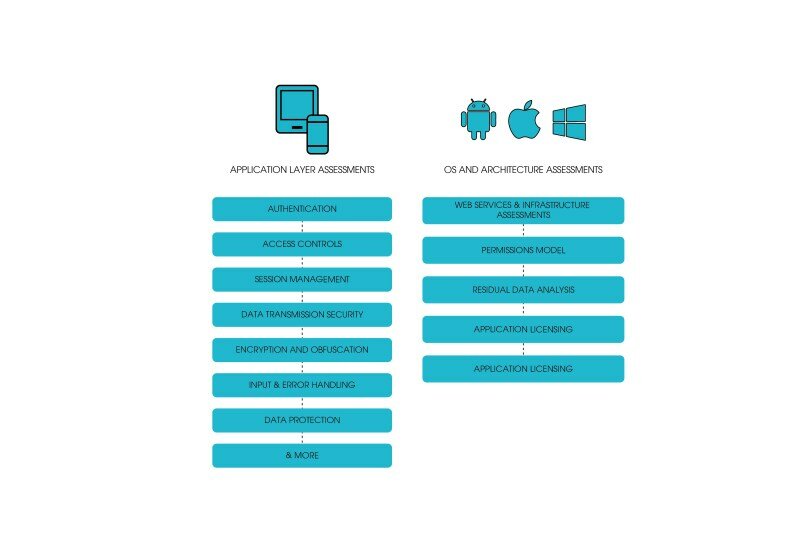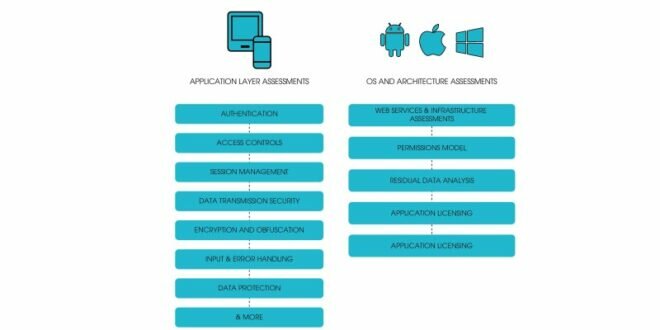
Mobile Application Penetration Testing – For effective penetration testing, effective analysis of a system or application is performed to identify problems and gather information quickly. In this article, we will look at the tools that should be used for any kind of penetration testing for Android and iOS. This article looks at what each of these tools are for, how to install and configure them step-by-step, details on their use cases, and more. All the tools mentioned in the article can perform multiple functions such as data collection, obfuscation, forensics, code analysis, reverse engineering and various other test cases depending on the requirements.
APKAnalyser is a Java based application program (GUI) tool that can perform static and virtual analysis. This tool provides the following detailed information during static code analysis:
Mobile Application Penetration Testing

Drozer tool is one of the best dynamic analysis tool that allows you to identify security holes in application and device. Its unique feature allows Dalvik to communicate with VM, IPC and OS.
Pentest: Mobile Application Penetration Testing Tools
APKTool is a Java-based program that is mainly used by security testers in the security assessment of Android applications, it can decode an APK file almost to its original source code, and allows you to make changes to the code and rebuild it. APKTool can also be used to debug any Android app. Here are its important features:
JD-GUI is used to display all Java source code of all .class files and it allows us to browse the regenerated code for immediate access to all methods and fields in JAR files. It is a standalone program and can be downloaded from http://jd.benow.ca/.
Androguard is a set of built-in tools that can perform various tasks; It is mainly used in the reverse engineering process of malware. In the current state of Android app evaluation, Androguard is one of the most effective reverse engineering tools.
Java Debugger (JDB) is a useful tool for debugging Java programs. Debugging is an important activity in manipulating a program to break security trusts through breakpoints, staging, and exception handling. One of the most powerful debugging techniques is to call a debugger to handle a variable at runtime. In this technique, testers/attackers usually look for a patch or hook to connect to the application code, and the execution is debugged in this piece of code, which provides the ability to parse and change the values of various variables and classes. as in interacting with program state. Runtime analysis can be done by debugging the program and then linking it to JDB.
Mobile Penetration Testing Company In Mumbai
Although there are many assessment tools available on the Internet, this article focuses on the important tools that are sufficient to assess known and unknown vulnerabilities. It is important to note that all the security tools presented here will only work on a jailbroken device.
As you know, apps in the Apple Store must be signed. You need oTool to decrypt these apps to perform binary analysis. oTool is widely used for manual decryption and detection of related misconfigurations when packaging and installing an application on a user’s device. This tool shares the necessary libraries to test any Mach-O binary.
The SSL Kill Switch tool was released by Blackhat in 2012. The iOS SSL Kill Switch tool is designed to disable SSL certificate verification, including certificate pinning, in iOS applications. This tool fixes the SSL functionality within the Secure Transport API to bypass the system’s default certificate deauthentication.
Keychain is a utility used to erase keychain data from a jailbroken device.
Web Application Penetration Testing
LLDB is the default debugger in Xcode and supports Objective-C debugging on iOS devices and the iOS simulator. LLDB works similarly to GDB and follows a client-server architecture.
Clutch is another great tool to use during penetration testing; It decodes and erases data for iPhone, iPod Touch and iPad applications.
Cycript (http://www.cycript.org) is the best runtime tool available for iOS application device; It uses JavaScript and Objective-C and can be installed by adding cydiasaurik.com to the repository. By default, this tool can be programmed into an iOS application device at runtime using an interactive console. Cycript can be very useful in breaking authentication logic and leaking information like encrypted keys from objects and loading additional view controllers.
Snoop-it plays a crucial role in the security assessment of iOS applications, and it provides many opportunities for automation, such as adding moc addresses and changing binary boolean values. It is one of the best tools for penetration testing. Snoop-it provides three main features: monitoring, analysis and runtime manipulation. Below is a list of things we can do with this tool:
Top Mobile Application Penetration Testing Tools For Android And Ios
In this article, we discussed various penetration testing tools and learned how to debug Android apps using JDB, iOS and LLDB. Using these tools, you can simulate real-time attacks on Android and iOS applications. Before attacking any application, it is always a best practice to look at the application from an attacker’s perspective and understand how the application’s threat model is implemented.
Give us 30 minutes and we’ll show you how many millions you can save with software testing. Raise the quality of your product to the highest level. Talk to us to see if mobile apps are the next big thing in the software world. As the number of smart devices continues to grow, so will the number of mobile apps. While recent innovations in mobile devices have made many tasks faster and easier, there is no denying that securing these troubleshooting applications is not an easy task.
Mobile apps are part of a larger mobile ecosystem that interacts with everything from the mobile device, network infrastructure, servers, and data centers. This leads to a complex attack surface. With the increasing use of mobile devices with advanced capabilities such as sensors, global positioning systems (GPS) and near field communication (NFC), the attack surface is further expanded. As cyber-attacks become more sophisticated and mobile app bug bounties are available, organizations are starting to invest in mobile app penetration testing.

The latest data reviewed by the Report shows that data breaches have increased dramatically in recent years. Hackers are developing new ways to access your personal information by hacking apps installed on your mobile devices.
Mobile Penetration Testing: An App Development Leader’s Guide
In the mobile app industry, there are three main types of apps that developers or organizations use to serve their customers. Each class runs code on a different type of device. Let’s take a look at these main types and what they contain.
Native mobile apps are apps that are downloaded onto mobile devices. These types of apps are usually built for a specific platform, such as Android or iOS. Various programming languages are used to build native applications such as Java, Kotlin, Python, Swift, Objective-C, C++ and React.
Hybrid mobile apps are a relatively new concept to mobile development. The goal is to combine the best of both worlds: iOS and Android apps. They run on the mobile operating system and can be downloaded from the Google Play Store or the Apple App Store.
A Google-built UI development kit for developing cross-platform apps from a single codebase for Android, iOS, Linux, Mac, Windows, Google Fuchsia, and the web.
Android And Ios App Penetration Testing
A progressive web application is a web-based software application that you install on a system. In short, a PWA is a web app, but looks like a regular (native) mobile app. The main goal of PWA is to bring the best of the web to the world of apps and remove the challenges and limitations of traditional apps. A PWA works like a normal website and can be opened and used in any browser (including mobile browsers), but the main difference is that PWA apps also work as mobile apps and can be added to the home screen for access like a native app. .
1. Dangerous Data Storage: Data storage is one of the most important aspects of any app or device. If an application stores, transmits, or processes sensitive data, they must keep it secure. This usually happens when developers wrongly assume that users or malware cannot access certain device or system files. Hackers can access your device data or steal your data if you don’t keep it safe.
2. Untrusted Input: The concept of trusted user input is not new. However, most developers don’t know how it works, what problems it causes, and how to protect themselves from it. This is especially important for mobile apps, because most of their source code is available on the Internet, so there is no point in hiding it.

3. Unreliable Communication: Unreliable communication is a threat that can never be ignored. When mobile apps are not carefully designed, they can leave their back-end systems vulnerable to hackers. When mobile apps go live
Mobile Application Pentest Or Desktop App Penetration Test
Application security penetration testing, mobile application penetration testing service, mobile application penetration testing tools, android application penetration testing, application penetration testing tools, mobile application penetration testing methodology, application penetration testing services, desktop application penetration testing, application penetration testing methodology, application penetration testing, ios application penetration testing, web application penetration testing
 GoInspiration | Best Forex, Stock, Gadget, and Internet Information Apps
GoInspiration | Best Forex, Stock, Gadget, and Internet Information Apps